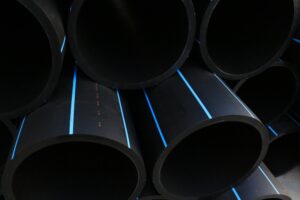Understanding Anaerobic Digester Systems: A Comprehensive Guide

Anaerobic digester system
Want to maximise anaerobic digester systems?
Anaerobic digestion reduces greenhouse gas emissions by recovering waste methane. Construction and operation vary by waste stream. We want to use water more efficiently. Industrial water treatment is difficult for businesses. Using an anaerobic digester with researchers is one of the oldest water waste treatments. In oxygen-free environments, anaerobic bacteria produce biogas from organic contaminants or chemical oxygen needs.
This article covers everything from the types of anaerobic digester system to their operation. We will explore feedstock sources, describe the process step-by-step, and analyse different types of equipment.
Prepare to transform your waste management and use green energy.
How anaerobic digester systems work?
Innovative anaerobic digester systems use anaerobic microorganisms to convert organic waste into valuable resources. Sustainable solid waste management is dependent on these systems for renewable energy production. Hence, we’ll talk about what is good for them: advantages, components, materials etc.
Anaerobic digestion is a process that involves bacteria decomposing organic matter without oxygen being present in the environment. Anaerobic bacteria are involved in complex processes within ADs. The process consists of four stages.
- Hydrolysis: Complex organic molecules are simplified.
- Acidogenesis: Simpler chemicals become volatile fatty acids.
- Acetogenesis: Volatile fatty acids become acetic acid, hydrogen and carbon dioxide during acetogenesis.
- Methanogenesis: Methane-producing bacteria convert acetic acid + hydrogen → methane + carbon dioxide (biogas).
Benefits of anaerobic digester systems
- Renewable Energy: Anaerobic digestion produces biogas that can be utilised to generate power, heat, or car fuel.
- Waste Reduction and Recycling: Anaerobic digesters may treat agricultural, food, and sewage sludge, minimising landfill and incinerator waste.
- Economic Benefits: Anaerobic digester systems can sell biogas, digestate, carbon credits, and organic waste tipping fees.
- Environmental Benefits: Anaerobic digestion captures methane and produces nutrient-rich digestate, reducing greenhouse gas emissions and chemical fertiliser consumption.
Types of feedstock for Anaerobic Digesters
- Waste from agriculture: Manure, crop scraps, energy crops
- Wasted food: Food processing waste, leftovers, and outdated food
- Solid waste: Municipal Household organic waste portion
- Sewage slime: Wastewater treatment plant waste
- Industrial organic waste: Waste from culinary, beverage, and industrial processes
Types of Anaerobic Digesters
- Passive Systems:
A lagoon’s minimum upkeep helps collect biogas under an impermeable cover. The most common passive digester is a covered lagoon. One cell of a two-cell lagoon is covered, while the other is not. The first cell’s liquid level remains constant to facilitate manure breakdown, while the second cell’s fluctuates to store. Covered lagoon temperatures vary seasonally.
- Low-Rate System:
Plug Flow Digesters and Complete Mix Digesters are low-rate systems. Liquids stay in the entire mix digester for 20–30 days, producing biogas. A storage tank may hold a whole batch of manure for liquidization.
- High-Rate Systems:
Methane-producing bacteria in the anaerobic digestion boost efficiency. Before recycling the microbe-rich slurry, complete mix digesters separate solids with an external clarifier.
Anaerobic Digester System components
- Receiving and Preprocessing: Systems for gathering, storing, and making digestible organic material.
- Anaerobic Digester: The main reactor for anaerobic digestion is a sealed tank or vessel.
- Biogas Collection: The digestion process produces biogas, which can be captured, stored, and used.
- Digestate Management: Processing the nutrient-rich waste into fertiliser or soil amendment.
- Monitoring and Control Systems: Software and instruments to optimise digestion and ensure efficiency.
Environmental benefits of anaerobic digesters
- Anaerobic digester systemsprovide renewable energy and handle waste sustainably, making them useful in the circular economy.
- Anaerobic digestion reduces greenhouse gas emissions by preventing methane release. Methane is captured and used as biogas. Anaerobic digesters absorb and use methane to combat climate change.
- Biogas produced in anaerobic digestion systems can generate heat and power for renewable energy generation. This renewable energy source helps industrial power plants achieve a cleaner energy balance by reducing fossil fuel use.
- Anaerobic digestion produces digestate, which contains essential elements such as potassium, phosphate, and nitrogen. As natural fertilisers, these minerals reduce the demand for synthetic fertilisers and nutrient runoff that pollutes rivers. Industrial processes require water recycling.
- Anaerobic digestion can minimise the smells associated with organic waste. Anaerobic digesters reduce unpleasant emissions. Processing garbage in a controlled atmosphere can impact nearby populations.
- Anaerobic digestion enables sustainable management of organic waste streams. By removing organic waste from landfills, anaerobic digester systems reduce greenhouse gas emissions like methane and carbon dioxide.
Factors to consider when implementing an anaerobic digester system
To ensure anaerobic digestion system performance and efficiency, numerous elements must be considered. Consider these important factors:
Feedstock Availability and Composition:
- Verify the availability and composition of organic feedstock, such as agricultural waste, food waste, or sewage sludge.
- The feedstock’s moisture, carbon-to-nitrogen ratio, and inhibitors should be examined.
- Make sure the feedstock has enough nutrients for anaerobic microorganisms.
Infrastructure and Site Selection:
- Choose a place with enough room, water, energy, transportation, and feedstock sources nearby.
- Anaerobic digester land use, zoning, and environmental impact should be assessed.
- To support the Anaerobic digester system, evaluate roadways, storage, and grid connections.
Design and Technology of Digesters:
- Based on feedstock, biogas production, and operating needs, choose a continuous, batch, or semi-continuous anaerobic digester.
- Select the digester size and configuration that best suits feedstock and energy needs.
- Ensure the digester design includes temperature control, mixing, and biogas storage.
Biogas Utilization and Energy Conversion:
- Assess biogas utilisation and energy conversion options, including electricity generation, CHP systems, and car fuel.
- Check end-user availability and electrical grid connection.
- Determine biogas treatment and upgrading needs, such as impurity removal or compression.
Requirements for Regulation:
- Check and comply with all anaerobic digester construction and operation rules, permits, and licenses.
- Air, water, and waste management rules must be followed.
- Get local, environmental, and utility approvals.
Financial and Economic Considerations:
- A complete feasibility study should evaluate the project’s capital and operational expenses, revenue streams, and financial incentives.
- Investigate government grants, subsidies, and private contributions to fund anaerobic digester installation.
- Create a detailed business plan to attract investors and fund projects.
Operations and Maintenance Planning:
- Plan daily anaerobic digester operation and maintenance.
- Instruct staff on system operation, troubleshooting, and optimisation.
- Create a maintenance schedule to prolong equipment life and efficiency.
WOG strives to provide excellent services
Consumers who share pleasant experiences are the best at displaying the value of the business. We operate with optimism that our company will expand and become well-known. We’ll work hard daily to develop our corporate strategy. Thus, WOG Group solves this problem for wastewater-generating firms. We have researchers accessible and plans to satisfy future needs. We try to offer water conservation benefits. Due to our effluent treatment projects, we are a leading supplier of effluent water treatment facilities. We provide industrial wastewater treatment plant services.




